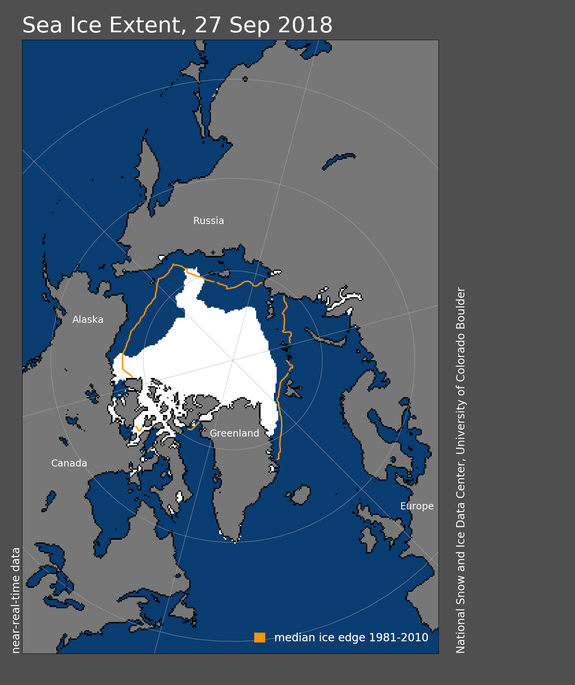An appreciation of the persistently grim tweets from the Norway Ice Service

Monday through Friday of each week, the Norwegian Ice Service, a government agency within the Norwegian Meteorological Institute, tweets out rather dismal news about the state of the thawing Arctic.
But these tweets aren't intended to be grim. They're simply an objective account of the modern Arctic reality. Each morning, the agency puts the current sea ice cover over a large swath of ocean between Norway and the North Pole into an emotionless, historical perspective.
Take, for instance, a post from August 22, 2018:
This is the lowest area for this day of the year in our records dating back to 1967.
— Norway Ice Service (@Istjenesten) August 22, 2018
The happenings in this 600,000-square kilometer area monitored by the Ice Service are consistent with what's occurring in the greater Arctic: Of the nearly 40 years of satellite records observed by the National Snow and Ice Data Center, each of the last 12 years have seen the 12 lowest ice extents on record.
"It's certainly really reinforcing that we are on a declining trend — and we can expect it to go lower," Nick Hughes, head of the Norwegian Ice Service, said in an interview.
Arctic sea ice is now vanishingly at an accelerating rate. As more ice melts, there are significantly fewer bright, white surfaces to reflect the sun's energy back into space. Instead, the ocean absorbs the heat, further boosting the warming over the expansive Arctic.
SEE ALSO: The wilderness has returned to idyllic Cape Cod. That means great white sharks.
"Sea ice cover at the end of Arctic summers has dropped precipitously since the 1980s," Yarrow Axford, a climate and Arctic scientist at Northwestern University, said over email. "It’s one of the most profound changes we’ve witnessed in terms of climate change so far."
In the Norwegian corner of the Arctic, the Ice Service is in a particularly good position to put the present ice cover into a greater historical perspective.
This is the 2nd lowest area on record for this day of the year, only 2004 (133,892 sq km) was lower.
— Norway Ice Service (@Istjenesten) August 15, 2018
"We have about 50 years of records," said Hughes. "We’re one of the first users of satellite imaging technology."
But the Ice Service doesn't just exist to send daily Twitter updates.
The agency came into being half a century ago to provide navigation support for Norwegian mariners on the high seas. Today, with less ice cover, more vessels are able to use the waters, which makes the Ice Service increasingly relevant.
"There’s more hazards to be aware of," said Hughes. "Even though there’s this decline in cover, there’s a need to stay vigilant for changing ice conditions."
Loss and variability of August #Arctic sea ice volume...
+ Model (PIOMAS) info/validation: https://t.co/UDsruDEI5p
+ Additional graphics: https://t.co/bTAfMZhjL1 pic.twitter.com/2YNhTPXoym— Zack Labe (@ZLabe) September 22, 2018
Hughes and his team, then, keep quite busy as all types of fishing, transportation, and natural gas vessels navigate through the precarious, frigid waters.
And this a primary reason why the daily tweets are so stark, emotionless, and similar. Lacking time to always type and send out the tweets, a bot — not a human — gathers the day's ice updates, uses the prewritten text, and then sends it out to the account's waiting followers.
The tweets actually arrive each morning in pairs: One with a stark statement, and the other with raw numbers illustrating just how many square kilometers below the historical average the ice presently sits.
The #Svalbard #seaice area from the ice chart for 23rd Aug 2018 is 124,738 sq km. This is 104,909 sq km below the 1981-2010 average. #Arctic
— Norway Ice Service (@Istjenesten) August 23, 2018
For perspective, 1 square kilometer is about the same total area as 187 football fields. So the ice cover on August 23, 2018 was 19.6 million football fields below the historical average.
That sounds like a lot. And it sounds grim. But it's reality.
"Unfortunately, grim is the state of change in the Arctic, and really globally at this point," Twila Moon, a scientist at the National Snow and Ice Data Center, said in an interview. "We’ve fundamentally changed some of the dominant features of the surface of the Arctic."
Naysayers might say that the Earth is billions of years old, and the Arctic has melted before. That's true, said Moon, who researches long-term environmental changes. But the Arctic — like the world — is warming at an unprecedented rate.
"The Earth has seen much higher and lower temperatures, but they happened through very slowly moving processes," said Moon. "We’ve created a system in which we’re really quickly creating carbon."

Image: national snow and ice data center
The levels of carbon dioxide in Earth's atmosphere are now the highest they've been in at least 800,000 years.
In the last 100 years, these carbon dioxide numbers, following in tandem with the burning of ancient fuels, have skyrocketed.
Both the Norwegian seas and the greater Arctic may seem far-off. And for many of us, it's thousands of miles away. But there's a reason why scientists are watching it so intently.
"The Arctic is like a canary in a coal mine, and it’s warning us that our planet’s climate is undergoing a really profound change," said Axford.
It's a reality that's difficult to ignore, as NASA and European Space Agency satellites now track the dwindling ice each day.
Accordingly, tweets from the Norway Ice Service will continue to arrive each morning, a bearer of straight, unfettered reality.
"It’s only once a day, so hopefully that’s not too much of a nuisance," said Hughes.
WATCH: Ever wonder how the universe might end?


